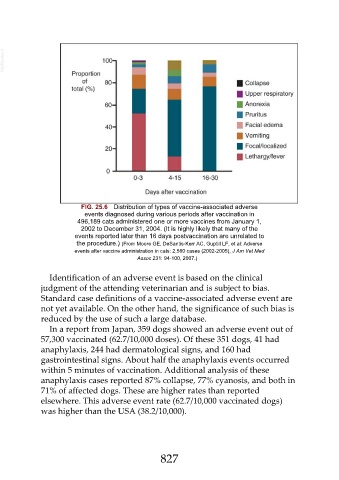Page 827 - Veterinary Immunology, 10th Edition
P. 827
VetBooks.ir
FIG. 25.6 Distribution of types of vaccine-associated adverse
events diagnosed during various periods after vaccination in
496,189 cats administered one or more vaccines from January 1,
2002 to December 31, 2004. (It is highly likely that many of the
events reported later than 16 days postvaccination are unrelated to
the procedure.) (From Moore GE, DeSantis-Kerr AC, Guptill LF, et al: Adverse
events after vaccine administration in cats: 2,560 cases (2002-2005), J Am Vet Med
Assoc 231: 94-100, 2007.)
Identification of an adverse event is based on the clinical
judgment of the attending veterinarian and is subject to bias.
Standard case definitions of a vaccine-associated adverse event are
not yet available. On the other hand, the significance of such bias is
reduced by the use of such a large database.
In a report from Japan, 359 dogs showed an adverse event out of
57,300 vaccinated (62.7/10,000 doses). Of these 351 dogs, 41 had
anaphylaxis, 244 had dermatological signs, and 160 had
gastrointestinal signs. About half the anaphylaxis events occurred
within 5 minutes of vaccination. Additional analysis of these
anaphylaxis cases reported 87% collapse, 77% cyanosis, and both in
71% of affected dogs. These are higher rates than reported
elsewhere. This adverse event rate (62.7/10,000 vaccinated dogs)
was higher than the USA (38.2/10,000).
827

